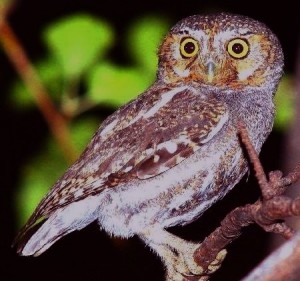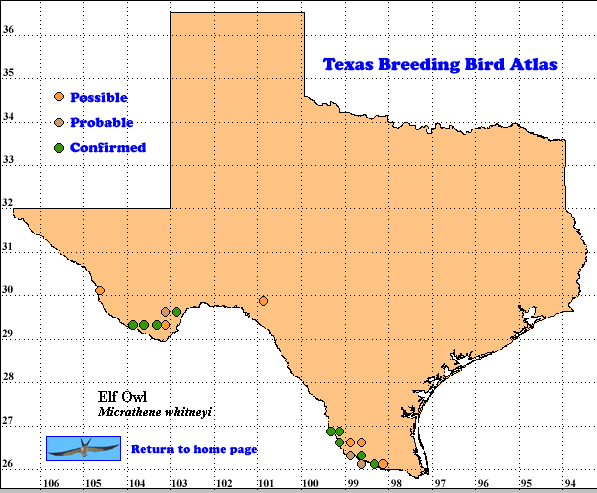The Elf Owl is a summer resident in the lower Big Bend region of western Texas and deep southern Texas. More observations of this species may indicate it id more abundant than previously thought. The smallest of all owls, measuring only about 13 cm (5 in) in length and weighing 35 to 55 gr (1.2 to 2 oz; BRM). This species may often be overlooked. Elf Owls are usually heard before seen, their puppy-like yelps and churrs can be heard from dusk to dawn during early spring. Two forms are represented in Texas: M. w/ idonea in southern Texas and M. w. whitneyi in western Texas and adjacent northern Mexico. The A.O.U. Checklist (1998) currently recognizes the two forms as conspecific (Pyle 1997) and TBBA records do not differentiate between the two forms.
DISTRIBUTION: In Texas, TBBA data indicates the Elf Owl as a breeding bird in deep south Texas and western Texas, west of the Pecos River. The gaps in breeding and sight records from the western Texas range east to Del Rio and southeast to the Falcon Dam, Sullivan City, Zapata and Bentsen Rio Grande State Park area where records again appear may be due to incomplete coverage in TBBA records. A recent study on the Black Gap Wildlife Management Area in southeastern Brewster County showed range expansion of the Elf Owl northward into the Marathon Basin (BRM). Oberholser (1974) stated “the elf owl inhabits chiefly the Big Bend region”.
Elf Owls also breed in northwest, northeast and Mexico amd is resident in Baja California Sur, Mexico. This owl winters in southwest Mexico from Guerrero to the Rio Balsas drainage (Howell and Webb 1995).
SEASONAL OCCURRENCE: Elf Owls are migratory, Males arrive back on breeding grounds in Texas in March (earliest fate February 24, and are followed shortly thereafter by the females. October 1 is the latest date Elf Owls have been observed in western Texas (Wauer 1996).The species is a rare winter resident in the lower Rio Grande valley (Lockwood and Freeman 2004). In western Texas the nesting chronology follows a set pattern: courtship, March and early April; incubation, April to mid May; hatching, mid-May to early June, and fledging from mid-June to mid-July (BRM).
BREEDING HABITAT. In southern Texas, TBBA records indicate Elf Owls were located in heavily wooded areas along the Rio Grande (latilong 26099) and in mesquite chaparral (latilong 26098). In western Texas, the TBBA records indicate the Elf Owl breeding from pine-oak woodland in the Chisos Mountains (latilong 31104) to low desert elevations (latilong 29103). In the Rio Grande valley Elf Owls breed in subtropical thorn woodland (acacia, mesquite, hackberry), and riparian woodland. They generally use old Ladder-backed (Picoides scalaris) and Golden-fronted (Melanerpes aurijfrons) woodpecker holes. In the Trans-Pecos these owls breed from 1050-1650 m (35000-5000 ft) in lowland desert (acacia, agave), desert- wash woodland (mesquite, acacia, hackberry), river and mountain canyon riparian forest (cottonwood, willow, ash) and adjacent evergreen woodland (oak, pine, juniper). Ladder-backed, Golden-fronted and Acorn (M. formicivorus) woodpecker holes are used. (Henry and Gehlbach 1999). This owl also uses nest boxes except when natural cavities are abundant (BRM).
The Elf Owl female lays an average of 3 (range 1 to 5) white eggs on the bare cavity bottom or wood debris and existing nesting material from other birds. Hatching occurs in about 28 days later and fledging takes place 28 to 33 days later.
STATUS. Elf Owl is an uncommon to locally common summer resident in its range in Texas. (Lockwood and Freeman 2004). The breeding density in the Santa Ana National Wildlife
Refuge averaged 5.0 pairs/km2 (13 pairs/mi2; Gehlbach 1987) and 0.3 (0.8) in the Guadalupe Mountains National Park (Newman 1979). A documented nesting in Iron County in 2992 is the most northerly recordd for Texas (Lockwood and Freeman 2004).
Text by Bonnie Reynolds McKinney (Posted with updates 2006).
Literature cited.
American Ornithologists’ Union. 1998. Checklist of North American birds, 7th ed. Am, Ornithol. Union, Washington, DC.
Henry, S. A. and F. R. Gehlbach. 1999. Elf Owl (Microthene whitneyi). InThe birds of North America, No. 413 (A. Poole and F. Gill, eds.). The Birds of North America, Inc., Philadelphia, PA.
Howell, S. N. G. and S. Webb. 1995. A guide to the birds of Mexico and northern Central America. Oxford University Press, New York.
Ligon, J. D. 1968. The biology of the Elf Owl, Microthene whitneyi. Univ. Mich Mus. Zool. Misc. Publ. 136.
Lockwood, M. W. and B. Freeman. 2004. The TOS handbook of Texas birds. Texas A&M University Press, College Station.
McKinney, B. R. 1996. The use of artificial nest boxes by Elf Owls in western Texas. Pp. 37-39 in Wildlife research highlights 1996. Vol.1. Texas Parks and Wildl. Dept., Austin.
Oberholser, H. C. 1974. The bird life of Texas, Vol. 1. University of Texas Press, Austin.
Pyle, P. 1997. Identification guide to North American birds, part 1. Slate Creek Press, Bolinas, CA.
Wauer, R. H. 1996. A field guide to birds of the big Bend. Gulf Publ., Houston, TX.

